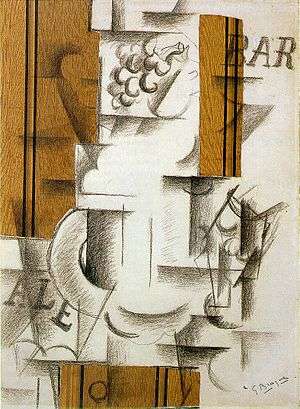Fruit Dish and Glass
Fruit Dish and Glass (1912) is the first papier collé,[1] by Georges Braque, a technique which Braque invented.[2]
| Fruit Dish and Glass | |
|---|---|
 | |
| Artist | Georges Braque |
| Year | 1912 |
| Medium | charcoal, wallpaper, gouache, paper, paperboard |
| Location | Metropolitan Museum of Art, US |
| Identifiers | The Met object ID: 490612 |
Braque was inspired to create this piece after visiting an Avignon shop where he purchased a roll of faux bois paper, simulating oak paneling and consisting of two kinds of printed motifs on a dark beige background.[1] Braque may have been drawn to this paper because he was trained in a technique called trompe-l'oeil; which allowed him to create pictorial effects that resemble woodgrain and marble finishes, but are made with paint and a special wide comb. Braque then may have found it amusing to incorporate the woodgrain paper in his piece. He may also have wished to use the paper to create a visual pun about the nature of representation. He noticed that because the paper looks realistic and yet it is flat, and pasted on, it undermines spatial relationships. It can act as the foreground, the background, or both.
In Fruit Dish and Glass the glass filled with grapes and pears are flattened and distorted versions of actual objects. Braque used textures, shapes, and composition to construct a painting that is half recognizable and half symbolic.
Process
The piece is based on the interaction of wallpaper glued to the support and charcoal lines, which evoke both objects and words. The subject matter is a glass bowl, pears, and grapes, between what looks like a dish and a wine glass, or perhaps a candlestick. Braque probably began the work by cutting out pieces of wallpaper and moving them around a flat surface to imagine his composition. He then might have positioned two strips of the wood grain wallpaper vertically on a large sheet of white paper to signify the walls of a café. He also put a small horizontal piece of wallpaper at the bottom of the paper to represent a table top. Then, he drew the glass, pears, grapes and the words ‘ALE’ and ‘BAR’ in charcoal and added black lines in ink to the wallpaper, and a circular knob to the horizon piece of wallpaper at the bottom to make it look like the drawer of a table. The work has a variety of textures that add confusion to spatial relations of the objects in the composition. For example, in addition to the oak wallpaper, Braque used a comb to add an additional element of trompe-l'oeil to give the piece even more perceptual distortion. Braque also adds texture, applying a mix of sand and gessoto the background. This texture brings the background forward, making it more difficult to interpret the perspective. Braque’s process was deliberately mystifying. His technique is full of subtleties that one doesn't notice at first. Both the physical and logical relationships of the objects are often difficult to construct. The painting is a visual puzzle which challenges the viewer to understand what is shown from clues and fragments.
Interpreting
In some places, the charcoal drawing overlaps the large vertical pieces of wallpaper so that the viewer can’t tell what is in the foreground and what is in the background. In doing so Braque is making a pun about the way objects are contained in space. In Braque’s world, objects can float next to the table and be all in one plane and in a third dimension all at once. In reality, the individual pieces are flat and meaningless, and then are built on one another to become somewhat dimensional and visually meaningful.
History
Braque first thought of creating these sorts of logical paradoxes after spotting a roll of faux-bois paper printed like oak paneling. He saw the paper in an Avignon shop while traveling with Picasso and his companion, Eva Gouel, in Sorgues.[1] Braque said that he eyed the paper but waited to act on his ideas until Picasso gone to Paris. Picasso was going to Paris for a week to organize his move to a new apartment on 242 Boulevard Raspail.[1] After Picasso had left, Braque bought the paper and made several works starting with Fruit Dish and Glass. When Picasso returned, Braque showed him his work; later, Picasso copied the technique. The work was purchased by one of Braque’s first collectors, Wilhelm Uhde. The piece remained with Uhde until 1921, when it was sold to a private collection.[1] The use of collage is usually credited with changing the face of cubism from analytic to synthetic. Analytic cubism used lines or tones to represent the world, while synthetic often used collage or painted areas resembling collage. These new devices created a constant tension between illusion and the use of real objects.
References
- pg 95-96 Bernard Zurcher [Georges Braque Life and Work] 0-8478-0986-2 1988.
- Cooper, Philip. Cubism. London: Phaidon, 1995, p. 14. ISBN 0714832502